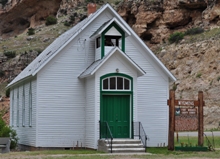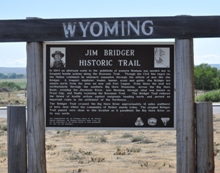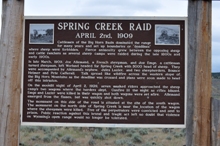Historical Markers
First Washakie County Church

Originally in Ten Sleep. Now located a few miles up Ten Sleep canyon on the Circle J Ranch.
March 14, 1901, Rev. L.C. Thompson, Rev. E.E. Tarbill, Mortimer Lewis, J.W. Carpenter, Kate Lynch and Mark Warner signed papers incoporating the Methodist Church of Ten Sleep and accepted land for a church building and cemetery from David Moses. The community raised $600, supplementing $300 given by Extension Society of Philadelphia. The building started in 1901 by volunteer labor with lumber donated by Milo Burk, was completed in 1904 and dedicated January 8, 1905. Each assisting familys was given a lot in the cemetery, where many pioneers rest. The church was moved to its present location [near the Ten Sleep Rodeo Grounds] in 1925. The annex was added in 1952. Moved to the Circle J in 1975.
Jim Bridger Historic Trail

Located 3 miles north of Worland on West River Road (Hwy 433).
In 1864 an alternate route to the goldfields of western Montana was needed due to frequent hostile actions along the Bozeman Trail. Though the Civil War raged on, the Nation continued its westward expansion through the efforts of men like Jim Bridger. A trapper, explorer, trader, hunter, scout and guide. Jim Bridger led miners north from the ara we now call Fort Caspar. From there the trail led northwesterly through the southern Big Horn Mountains, across the Big Horn Basin, crossing the Shoshone River, into Montana through what was known as Pryor Gap, and finally rejoining the Bozeman Trail. The Bridger Trail reduced the threat of hostile actions against emigrants heading north and proved an important route in the settlement of the Northwest.
The Bridger Trail crossed the Big Horn River approximately 12 miles southwest of here, near where the community of Neiber stands today. The original Bridger Trail passed very close to this location as it paralleled the Big Horn River on its way north.
Spring Creek Raid

Located south of Ten Sleep along Hwy 434.
April 2nd, 1909
Cattlemen of the Big Horn Basin dominated the range for many years and set up boundaries or "deadlines" where sheep were forbidden. Fierce animosity grew between the opposing sheep and cattle ranchers as several sheep camps were raided during the late 1800s and early 1900s.
In late March, 1909, Joe Allemand, a French sheepman, and Joe Emge, a cattleman turned sheepman, left Worland headed for Spring Creek with 5,000 head of sheep. They were accompanied by Allemand's nephew, Jules Lazier, and two sheepherders, Bounce Helmer and Pete Cafferall. Talk spread like wildfire across the western slope of the Big Horn Mountains as the deadline was crossed and plans were soon made to head off the intrusion.
On the moonlit night of April 2, 1909, seven masked riders approached the sheep camp's two wagons where the herders slept. Gunfire lit the night as rifles blazed. Emge and Lazier were killed in their wagon and both wagons were set afire. Allemand emerged from the flames, but was quickly shot down.
The monument on the side of the road is situated at the site of the south wagon. The monument on the north side of Spring Creek is near the location of the wagon where the sheepmen were killed. Five of the perpetrators were convicted and sent to prison. Public reaction against this brutal and tragic act left no doubt that violence on Wyoming's open range would no longer be tolerated.
Stephanie Ashby, County Coordinator


